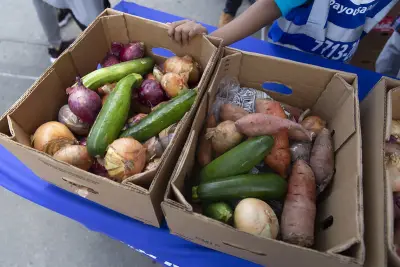Opinion: Congress Eliminated SNAP-Ed. Here’s What it Will Mean for New Yorkers.

“Without access to nutritious food, New Yorkers are at risk of rising rates of obesity, diabetes, and other preventable illnesses—and, our city’s children are affected the most. Their academic performance, mental health, and longterm well-being are all at risk.” A box of groceries at a food distribution event. Parents shouldn’t have to choose between feeding their kids food that’s affordable and food that’s healthy—but it’s a choice that countless New York City parents are forced to make every day.At Children’s Aid we see this struggle play out across the city, where families are forced to stretch their grocery budgets, skip meals, or settle for the cheapest calories they can find because healthier options are out of reach. That’s why from April through November we run our Food Box program every week in Harlem, the Bronx, Staten Island, and Washington Heights—to deliver farm-fresh, affordable produce directly to communities that need it most. But this vital program is at risk of being eliminated entirely. (function(d,u,ac){var s=d.createElement('script');s.type='text/javascript';s.src='https://a.omappapi.com/app/js/api.min.js';s.async=true;s.dataset.user=u;s.dataset.campaign=ac;d.getElementsByTagName('head')[0].appendChild(s);})(document,54625,'u4kmqsczew4vunxutxmd'); The Food Box is funded by SNAP-Ed—a federal program that supports nutrition education and healthy food access for low-income families. Congress’ new federal budget eliminates this funding as of Sept. 30, and now programs like ours may have to shut down altogether. Every week, our sites distribute boxes packed with nutrient-rich fruits and vegetables, enough to feed a family of four for an entire week. At just $14—or $7 with SNAP EBT—each Food Box helps stretch limited budgets while providing the healthy food kids need to grow strong and healthy. Across our sites, we distribute thousands of boxes each year, reaching families in neighborhoods where full-service grocery stores are scarce and food costs are soaring. Last year alone, we distributed more than 6,300 food boxes and hosted over 360 nutrition workshops for youth and adults. Over a thousand New Yorkers participated in these programs during the year. But numbers only tell part of the story. The real power of the Food Box program lives in what we hear from families. One mother of two young children recently shared that the program not only helped convert her sons from fast food to nutritious meals—it also made it financially possible for her to support her elderly mom and dad. Another told us that the program helped her eat healthier and reverse her prediabetes. We’ve heard across the board that the availability of fresh food via Food Box has helped the community to eat better and sparked a deeper interest in cooking and wellness. In too many New York City neighborhoods, especially those historically underserved, access to fresh food is still a daily challenge. Communities on Staten Island, where one of our Food Box programs operates, experience food deserts, especially on the North Shore. High prices, limited grocery options, and long-standing health inequities all compound to make nutritious food the exception rather than the norm—in fact, more than 1.2 million New Yorkers face food insecurity, and one in four can’t afford essentials as costs continue to rise. Without access to nutritious food, New Yorkers are at risk of rising rates of obesity, diabetes, and other preventable illnesses—and, our city’s children are affected the most. Their academic performance, mental health, and longterm well-being are all at risk. The Food Box program is part of the solution. It meets people where they are: at their local schools, community centers, and after-school programs. Whether it’s supporting older adults on a fixed income, youth in our after-school program, or busy working parents, the Food Box program helps remove the barriers that make healthy eating harder than it should be. It’s not a luxury. It’s a necessary part of a healthy city. Now, with SNAP-Ed funding eliminated, we risk undoing years of progress toward a healthier, more equitable New York. Skeptics have called SNAP-Ed duplicative. It isn’t. In fact, SNAP-Ed is the only federal nutrition education program focused specifically on low-income families and delivered in community settings. That’s why we need leaders who will step up and prioritize food security programs like these—with federal support disappearing, it’s never been more important. Now is not the time to take food off the table. It’s time to double down on what’s working and fight for continued investment in programs that nourish our families, support public health, and strengthen communities across our city. New York City’s families deserve better than empty shelves and empty promises. They deserve fresh, affordable food—and a government that makes it possible. Taisy Conk is the director of food and nutrition programs at Children’s Aid. The post Opinion: Congress Eliminated SNAP-Ed. Here’s What it Will Mean for New Yorkers. appeared first on City Limits.


